technical specifications Seat Alhambra 2012 Owner's Guide
[x] Cancel search | Manufacturer: SEAT, Model Year: 2012, Model line: Alhambra, Model: Seat Alhambra 2012Pages: 388, PDF Size: 6.72 MB
Page 45 of 388
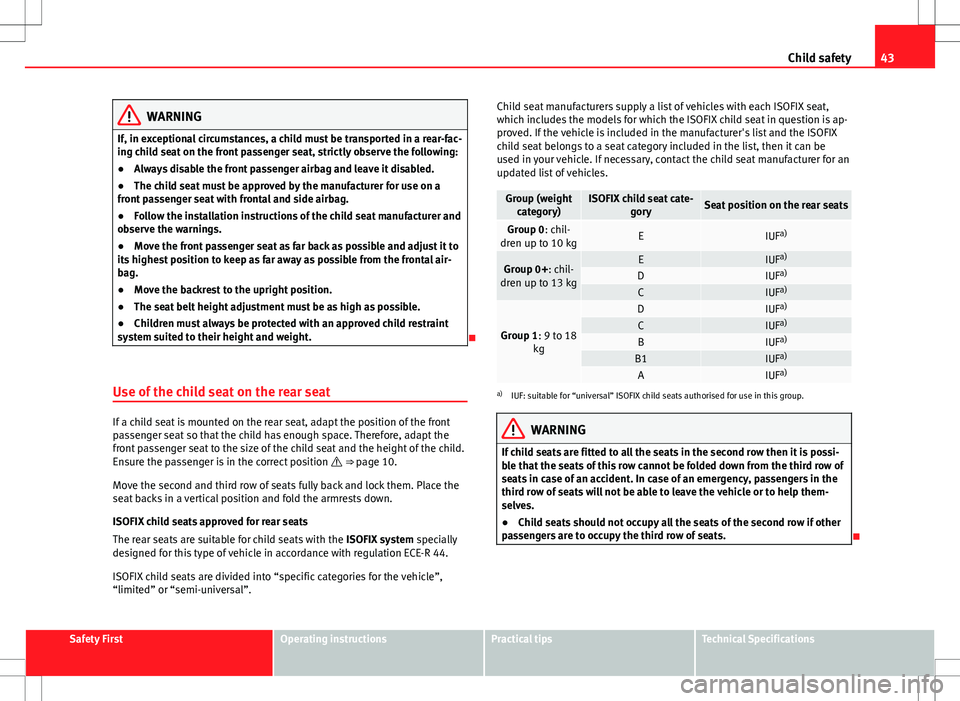
43
Child safety
WARNING
If, in exceptional circumstances, a child must be transported in a rear-fac-
ing child seat on the front passenger seat, strictly observe the following:
● Always disable the front passenger airbag and leave it disabled.
● The child seat must be approved by the manufacturer for use on a
front passenger seat with frontal and side airbag.
● Follow the installation instructions of the child seat manufacturer and
observe the warnings.
● Move the front passenger seat as far back as possible and adjust it to
its highest position to keep as far away as possible from the frontal air-
bag.
● Move the backrest to the upright position.
● The seat belt height adjustment must be as high as possible.
● Children must always be protected with an approved child restraint
system suited to their height and weight.
Use of the child seat on the rear seat
If a child seat is mounted on the rear seat, adapt the position of the front
passenger seat so that the child has enough space. Therefore, adapt the
front passenger seat to the size of the child seat and the height of the child.
Ensure the passenger is in the correct position ⇒ page 10.
Move the second and third row of seats fully back and lock them. Place the
seat backs in a vertical position and fold the armrests down.
ISOFIX child seats approved for rear seats
The rear seats are suitable for child seats with the ISOFIX system specially
designed for this type of vehicle in accordance with regulation ECE-R 44.
ISOFIX child seats are divided into “specific categories for the vehicle”,
“limited” or “semi-universal”. Child seat manufacturers supply a list of vehicles with each ISOFIX seat,
which includes the models for which the ISOFIX child seat in question is ap-
proved. If the vehicle is included in the manufacturer's list and the ISOFIX
child seat belongs to a seat category included in the list, then it can be
used in your vehicle. If necessary, contact the child seat manufacturer for an
updated list of vehicles.
Group (weight
category)ISOFIX child seat cate- gorySeat position on the rear seats
Group 0: chil-
dren up to 10 kgEIUF a)
Group 0+: chil-
dren up to 13 kgEIUF a)DIUFa)CIUFa)
Group 1: 9 to 18
kg
DIUFa)CIUFa)BIUFa)B1IUFa)AIUFa)a)
IUF: suitable for “universal” ISOFIX child seats authorised for use in this group.
WARNING
If child seats are fitted to all the seats in the second row then it is possi-
ble that the seats of this row cannot be folded down from the third row of
seats in case of an accident. In case of an emergency, passengers in the
third row of seats will not be able to leave the vehicle or to help them-
selves.
● Child seats should not occupy all the seats of the second row if other
passengers are to occupy the third row of seats.
Safety FirstOperating instructionsPractical tipsTechnical Specifications
Page 47 of 388

45
Child safety
● Tighten the straps evenly using the corresponding adjustment device.
The child seat must sit flush against the vehicle seat.
● Pull on both sides of the child seat to ensure that it is secure.
WARNING
The lower anchor points for child seats do not include rings. Only secure
booster seats to lower anchor points.
Securing a child seat using a Top Tether retaining strap
Fig. 28 Upper retaining
strap hooked in the lug-
gage compartment
● Observe the manufacturer's instructions when installing and removing
the child seat ⇒
.
● Raise the head restraint behind the child seat until it engages.
● Secure the child seat to the lower anchor points ⇒ page 44.
● Pull the upper child seat retaining strap back to the backrest of the rear
seat, below or on both sides of the head restraint (depending on the child
seat model). ●
Hook the upper retaining strap to the corresponding retaining ring (for
TOP TETHER) on the back of the backrest on the rear seat ⇒ fig. 28.
● Push the head restraint down as far as it will go. Ensure that it does not
interfere with the seatbelt from the upper attachment.
● Tighten the strap so that the top of the child seat rests on the backrest.
WARNING
Child seats with lower anchor points and with an upper retaining strap
must be installed in line with the manufacturer's instructions. Failure to
comply could result in severe injuries.
● Always secure just one retaining strap from a child seat to a retaining
ring (for TOP TETHER) on backrest on the rear seat in the luggage com-
partment.
● Never secure a child seat to the retaining rings.
● Never secure a child seat to the movable attachment elements for ve-
hicles with an attachment element and rail system .
Integrated child seat Introduction
The integrated child seat is only suitable for children in Group 2 (15-25 kg)
and Group 3 (22-36 kg), according to the ECE-R 44 regulation.
Additional information and warnings:
● Seat belts ⇒ page 21
Safety FirstOperating instructionsPractical tipsTechnical Specifications
Page 49 of 388

47
Child safety
Unfolding the integrated child seat
Fig. 29 Integrated child
seats. lift up the cushion.
Fig. 30 Integrated child seats. position the head re-
straint over the side head restraint A and fit into place
B.
The integrated child seat can be fitted with a side head restraint. SEAT rec-
ommends use of the integrated child seat with the side head restraint fitted
and also that this seat be used only for children above the age of 3.
Safety FirstOperating instructionsPractical tipsTechnical Specifications
Page 51 of 388

49
Child safety
Seat belt guide handle
● Secure the seat belt guide handle to the side head restraint on the win-
dow side. The guide handle is secured by a button.
● Open the upper button on the seat belt guide handle and pass the belt
webbing below the side head restraint and through the guide handle.
● Close the button again.
Adjusting the belt routing
● Guide the automatic three-point seat belt below the side head restraint.
● Pull the latch plate and slowly place the belt webbing across the child's
chest and lap.
● Insert the latch plate into the buckle for the appropriate seat and push it
down until it is securely locked with an audible click.
● Pull the belt to ensure that the latch plate is securely engaged in the
buckle.
WARNING
The seat belt only offers maximum protection from severe or fatal injuries
when it is correctly positioned.
● Children must assume the proper sitting position and be properly bel-
ted in while travelling.
● The shoulder belt must be positioned against the middle of the
shoulder.
● The seat belt must lie flat and fit comfortably.
● Allow the belt to retract until it fits tightly over the child's seat.
● The lap part of the seat belt must lie across the pelvis, never across
the stomach.
● Only one child may occupy a child seat.
Removing the seat belt
Fig. 33 Integrated
child seats. lowering
the cushion.
Lowering the cushion
● Pull the unlock lever ⇒ fig. 33 A
on the cushion in the direction of the
arrow 1.
● Push the cushion down through the central area B in the direction of
the arrow 2 until it safely engages
⇒ . The side supports fold away auto-
matically.
Removing the side head restraint
● Open the seat belt guide handle.
● Guide the seat belt by hand to pull the belt back in more easily and not
damage the trim.
● Push the head restraint up as far as it will go.
● Fold the backrest of the rear seat forwards ⇒ page 117.
● Remove the head restraint along with the side head restraint.
● Remove the head restraint and side head restraint by pulling on it.
● Fitting the head restraint.
Safety FirstOperating instructionsPractical tipsTechnical Specifications
Page 53 of 388

51
Child safety
Safety FirstOperating instructionsPractical tipsTechnical Specifications
Page 55 of 388
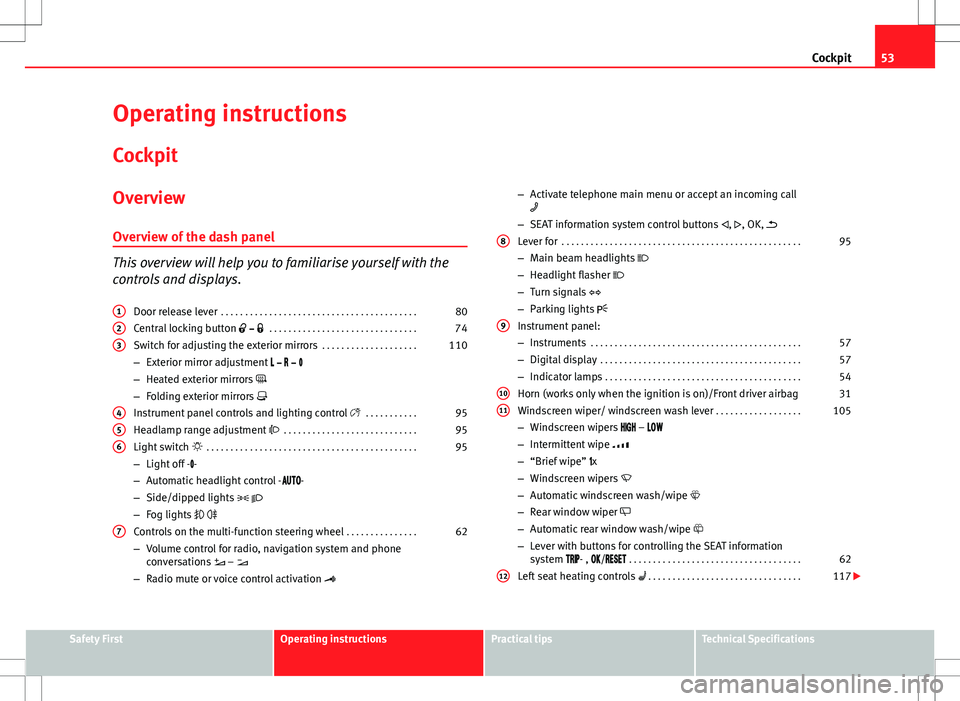
53
Cockpit
Operating instructions Cockpit
Overview Overview of the dash panel
This overview will help you to familiarise yourself with the
controls and displays. Door release lever . . . . . . . . . . . . . . . . . . . . . . . . . . . . . . . . . . . . . . . . . 80
Central locking button . . . . . . . . . . . . . . . . . . . . . . . . . . . . . . . 74
Switch for adjusting the exterior mirrors . . . . . . . . . . . . . . . . . . . .110
– Exterior mirror adjustment
– Heated exterior mirrors
– Folding exterior mirrors
Instrument panel controls and lighting control . . . . . . . . . . .95
Headlamp range adjustment . . . . . . . . . . . . . . . . . . . . . . . . . . . . 95
Light switch . . . . . . . . . . . . . . . . . . . . . . . . . . . . . . . . . . . . . . . . . . . . 95
– Light off - -
– Automatic headlight control - -
– Side/dipped lights
– Fog lights
Controls on the multi-function steering wheel . . . . . . . . . . . . . . .62
– Volume control for radio, navigation system and phone
conversations –
– Radio mute or voice control activation
1
23
456
7
–
Activate telephone main menu or accept an incoming call
– SEAT information system control buttons , , OK,
Lever for . . . . . . . . . . . . . . . . . . . . . . . . . . . . . . . . . . . . . . . . . . . . . . . . . . 95
– Main beam headlights
– Headlight flasher
– Turn signals
– Parking lights
Instrument panel:
– Instruments . . . . . . . . . . . . . . . . . . . . . . . . . . . . . . . . . . . . . . . . . . . . 57
– Digital display . . . . . . . . . . . . . . . . . . . . . . . . . . . . . . . . . . . . . . . . . . 57
– Indicator lamps . . . . . . . . . . . . . . . . . . . . . . . . . . . . . . . . . . . . . . . . . 54
Horn (works only when the ignition is on)/Front driver airbag 31
Windscreen wiper/ windscreen wash lever . . . . . . . . . . . . . . . . . .105
– Windscreen wipers –
– Intermittent wipe
– “Brief wipe” x
– Windscreen wipers
– Automatic windscreen wash/wipe
– Rear window wiper
– Automatic rear window wash/wipe
– Lever with buttons for controlling the SEAT information
system - , / . . . . . . . . . . . . . . . . . . . . . . . . . . . . . . . . . . . . 62
Left seat heating controls . . . . . . . . . . . . . . . . . . . . . . . . . . . . . . . . 117
8
9
1011
12
Safety FirstOperating instructionsPractical tipsTechnical Specifications
Page 57 of 388
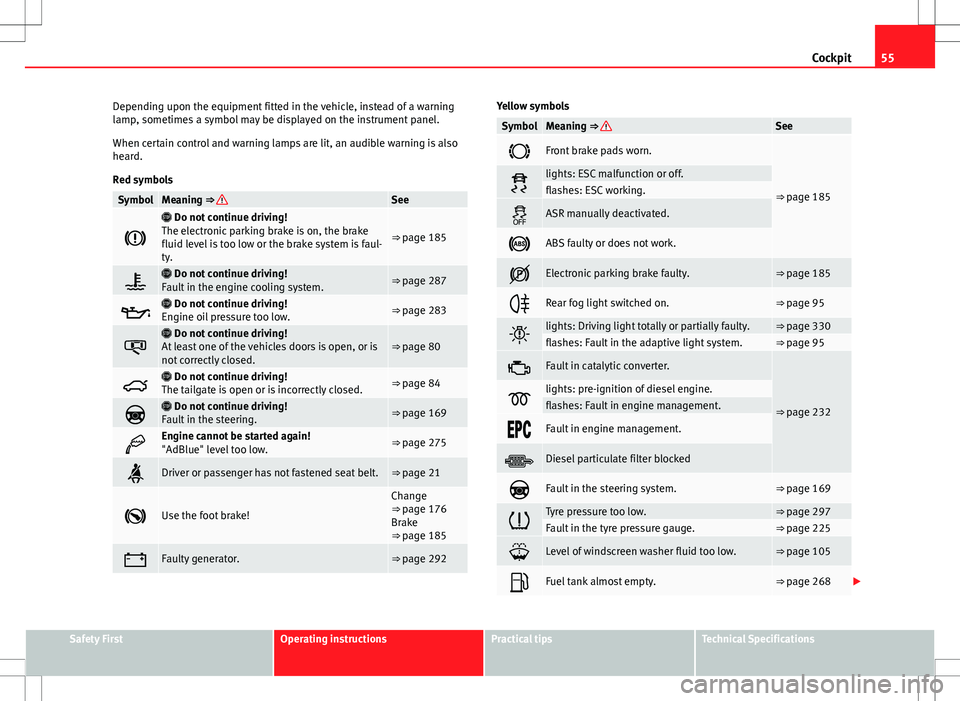
55
Cockpit
Depending upon the equipment fitted in the vehicle, instead of a warning
lamp, sometimes a symbol may be displayed on the instrument panel.
When certain control and warning lamps are lit, an audible warning is also
heard.
Red symbols
SymbolMeaning ⇒ See
Do not continue driving!
The electronic parking brake is on, the brake
fluid level is too low or the brake system is faul-
ty.
⇒ page 185
Do not continue driving!
Fault in the engine cooling system.⇒ page 287
Do not continue driving!
Engine oil pressure too low.⇒ page 283
Do not continue driving!
At least one of the vehicles doors is open, or is
not correctly closed.⇒ page 80
Do not continue driving!
The tailgate is open or is incorrectly closed.⇒ page 84
Do not continue driving!
Fault in the steering.⇒ page 169
Engine cannot be started again!
"AdBlue" level too low.⇒ page 275
Driver or passenger has not fastened seat belt.⇒ page 21
Use the foot brake!
Change
⇒ page 176
Brake
⇒ page 185
Faulty generator.⇒ page 292
Yellow symbols
SymbolMeaning ⇒ See
Front brake pads worn.
⇒ page 185lights: ESC malfunction or off.flashes: ESC working.
ASR manually deactivated.
ABS faulty or does not work.
Electronic parking brake faulty.⇒ page 185
Rear fog light switched on.⇒ page 95
lights: Driving light totally or partially faulty.⇒ page 330flashes: Fault in the adaptive light system.⇒ page 95
Fault in catalytic converter.
⇒ page 232lights: pre-ignition of diesel engine.flashes: Fault in engine management.
Fault in engine management.
Diesel particulate filter blocked
Fault in the steering system.⇒ page 169
Tyre pressure too low.⇒ page 297Fault in the tyre pressure gauge.⇒ page 225
Level of windscreen washer fluid too low.⇒ page 105
Fuel tank almost empty.⇒ page 268
Safety FirstOperating instructionsPractical tipsTechnical Specifications
Page 59 of 388
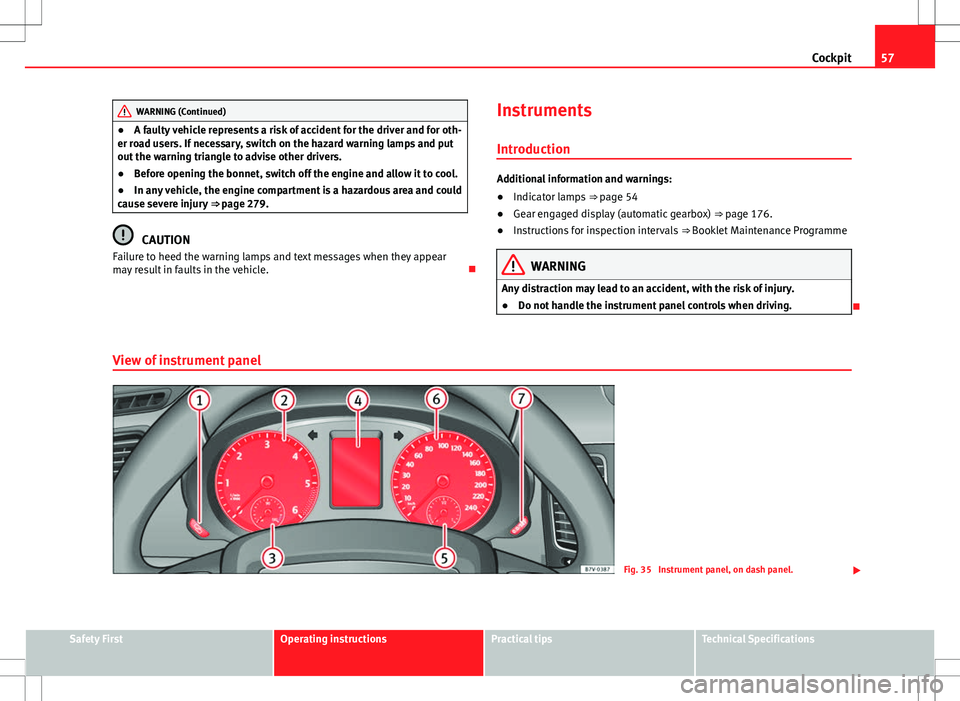
57
Cockpit
WARNING (Continued)
● A faulty vehicle represents a risk of accident for the driver and for oth-
er road users. If necessary, switch on the hazard warning lamps and put
out the warning triangle to advise other drivers.
● Before opening the bonnet, switch off the engine and allow it to cool.
● In any vehicle, the engine compartment is a hazardous area and could
cause severe injury ⇒ page 279.
CAUTION
Failure to heed the warning lamps and text messages when they appear
may result in faults in the vehicle. Instruments
Introduction
Additional information and warnings:
● Indicator lamps ⇒ page 54
● Gear engaged display (automatic gearbox) ⇒ page 176.
● Instructions for inspection intervals ⇒ Booklet Maintenance Programme
WARNING
Any distraction may lead to an accident, with the risk of injury.
● Do not handle the instrument panel controls when driving.
View of instrument panel
Fig. 35 Instrument panel, on dash panel.
Safety FirstOperating instructionsPractical tipsTechnical Specifications
Page 61 of 388
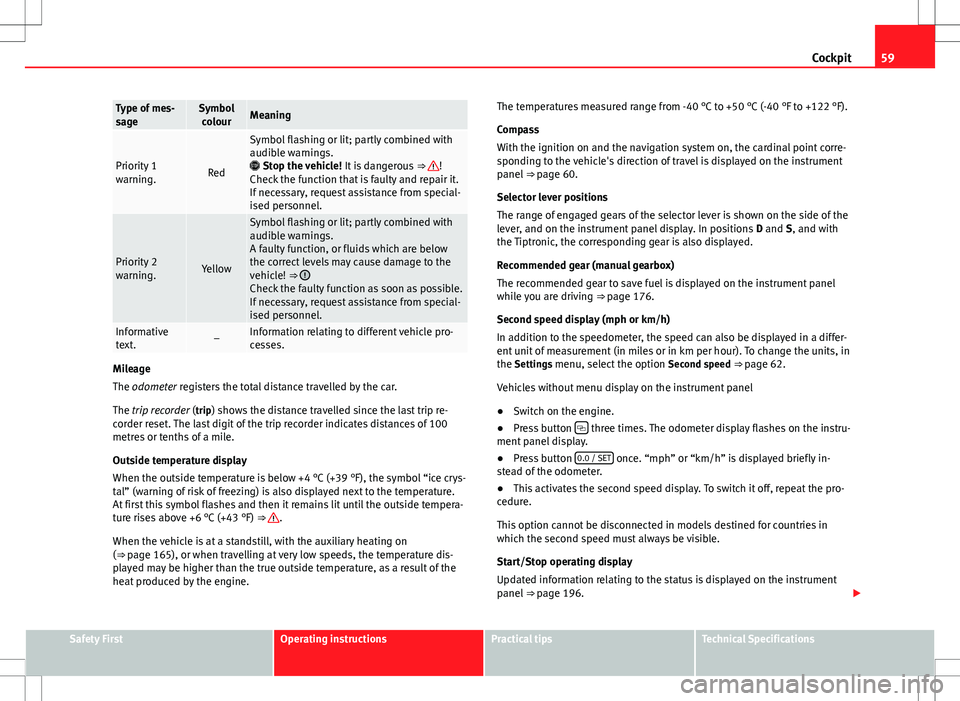
59
Cockpit
Type of mes-
sageSymbol
colourMeaning
Priority 1
warning.Red
Symbol flashing or lit; partly combined with
audible warnings.
Stop the vehicle! It is dangerous ⇒
!
Check the function that is faulty and repair it.
If necessary, request assistance from special-
ised personnel.
Priority 2
warning.Yellow
Symbol flashing or lit; partly combined with
audible warnings.
A faulty function, or fluids which are below
the correct levels may cause damage to the
vehicle! ⇒
Check the faulty function as soon as possible.
If necessary, request assistance from special-
ised personnel.
Informative
text.–Information relating to different vehicle pro-
cesses.
Mileage
The odometer registers the total distance travelled by the car.
The trip recorder (trip) shows the distance travelled since the last trip re- corder reset. The last digit of the trip recorder indicates distances of 100
metres or tenths of a mile.
Outside temperature display
When the outside temperature is below +4 °C (+39 °F), the symbol “ice crys-
tal” (warning of risk of freezing) is also displayed next to the temperature.
At first this symbol flashes and then it remains lit until the outside tempera-
ture rises above +6 °C (+43 °F) ⇒
.
When the vehicle is at a standstill, with the auxiliary heating on
(⇒ page 165), or when travelling at very low speeds, the temperature dis-
played may be higher than the true outside temperature, as a result of the
heat produced by the engine. The temperatures measured range from -40 °C to +50 °C (-40 °F to +122 °F).
Compass
With the ignition on and the navigation system on, the cardinal point corre-
sponding to the vehicle's direction of travel is displayed on the instrument
panel
⇒ page 60.
Selector lever positions
The range of engaged gears of the selector lever is shown on the side of the
lever, and on the instrument panel display. In positions D and S, and with
the Tiptronic, the corresponding gear is also displayed.
Recommended gear (manual gearbox)
The recommended gear to save fuel is displayed on the instrument panel
while you are driving ⇒ page 176.
Second speed display (mph or km/h)
In addition to the speedometer, the speed can also be displayed in a differ-
ent unit of measurement (in miles or in km per hour). To change the units, in
the Settings menu, select the option Second speed ⇒ page 62.
Vehicles without menu display on the instrument panel
● Switch on the engine.
● Press button
three times. The odometer display flashes on the instru-
ment panel display.
● Press button 0.0 / SET
once. “mph” or “km/h” is displayed briefly in-
stead of the odometer.
● This activates the second speed display. To switch it off, repeat the pro-
cedure.
This option cannot be disconnected in models destined for countries in
which the second speed must always be visible.
Start/Stop operating display
Updated information relating to the status is displayed on the instrument
panel ⇒ page 196.
Safety FirstOperating instructionsPractical tipsTechnical Specifications
Page 63 of 388
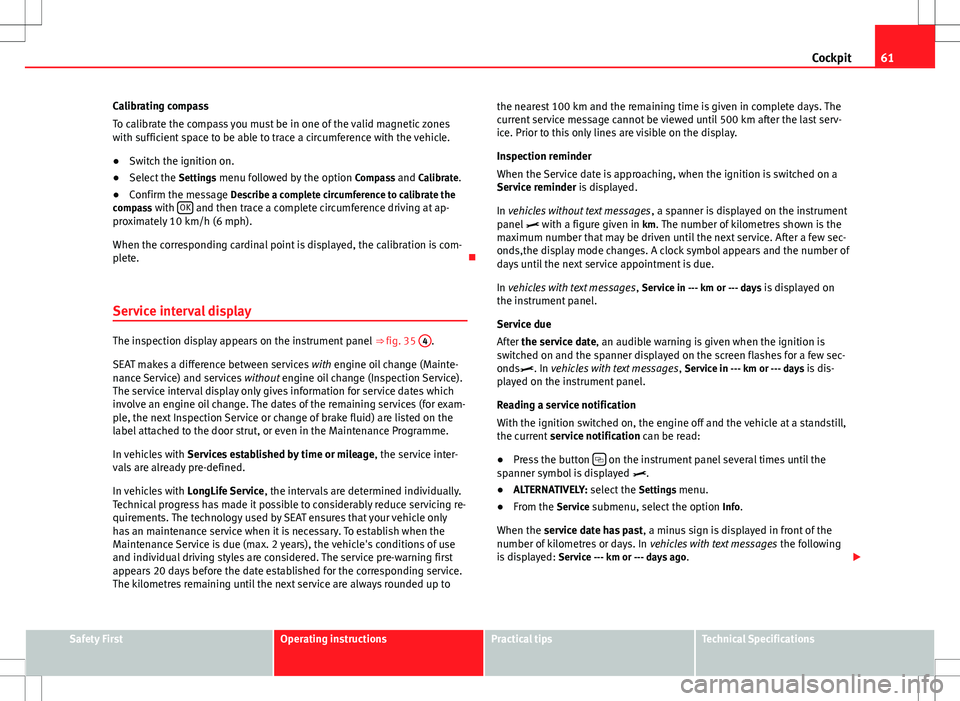
61
Cockpit
Calibrating compass
To calibrate the compass you must be in one of the valid magnetic zones
with sufficient space to be able to trace a circumference with the vehicle.
● Switch the ignition on.
● Select the Settings menu followed by the option Compass and Calibrate.
● Confirm the message Describe a complete circumference to calibrate the
compass with OK
and then trace a complete circumference driving at ap-
proximately 10 km/h (6 mph).
When the corresponding cardinal point is displayed, the calibration is com-
plete.
Service interval display
The inspection display appears on the instrument panel ⇒ fig. 35 4.
SEAT makes a difference between services with engine oil change (Mainte-
nance Service) and services without engine oil change (Inspection Service).
The service interval display only gives information for service dates which
involve an engine oil change. The dates of the remaining services (for exam-
ple, the next Inspection Service or change of brake fluid) are listed on the
label attached to the door strut, or even in the Maintenance Programme.
In vehicles with Services established by time or mileage , the service inter-
vals are already pre-defined.
In vehicles with LongLife Service , the intervals are determined individually.
Technical progress has made it possible to considerably reduce servicing re-
quirements. The technology used by SEAT ensures that your vehicle only
has an maintenance service when it is necessary. To establish when the
Maintenance Service is due (max. 2 years), the vehicle's conditions of use
and individual driving styles are considered. The service pre-warning first
appears 20 days before the date established for the corresponding service.
The kilometres remaining until the next service are always rounded up to the nearest 100 km and the remaining time is given in complete days. The
current service message cannot be viewed until 500 km after the last serv-
ice. Prior to this only lines are visible on the display.
Inspection reminder
When the Service date is approaching, when the ignition is switched on a
Service reminder is displayed.
In vehicles without text messages
, a spanner is displayed on the instrument
panel with a figure given in km. The number of kilometres shown is the
maximum number that may be driven until the next service. After a few sec-
onds,the display mode changes. A clock symbol appears and the number of
days until the next service appointment is due.
In vehicles with text messages , Service in --- km or --- days is displayed on
the instrument panel.
Service due
After the service date, an audible warning is given when the ignition is
switched on and the spanner displayed on the screen flashes for a few sec-
onds. In vehicles with text messages , Service in --- km or --- days is dis-
played on the instrument panel.
Reading a service notification
With the ignition switched on, the engine off and the vehicle at a standstill,
the current service notification can be read:
● Press the button
on the instrument panel several times until the
spanner symbol is displayed .
● ALTERNATIVELY: select the Settings menu.
● From the Service submenu, select the option Info.
When the service date has past , a minus sign is displayed in front of the
number of kilometres or days. In vehicles with text messages the following
is displayed: Service --- km or --- days ago .
Safety FirstOperating instructionsPractical tipsTechnical Specifications